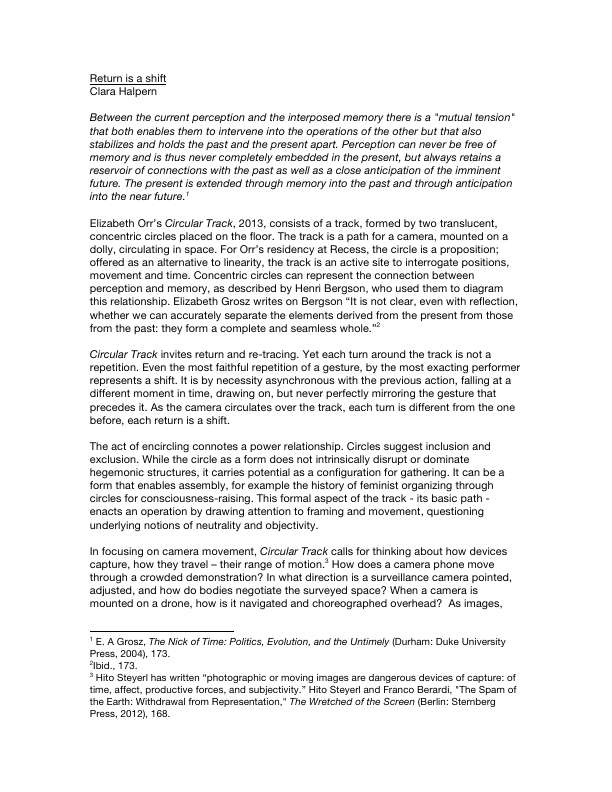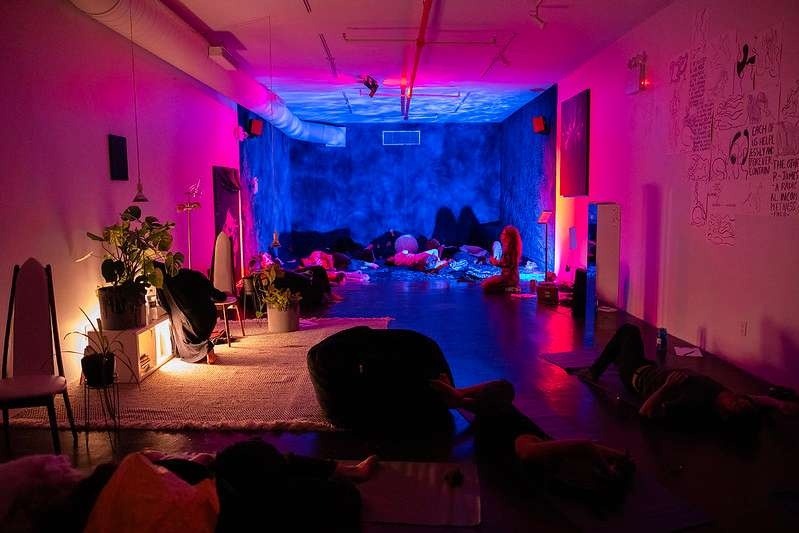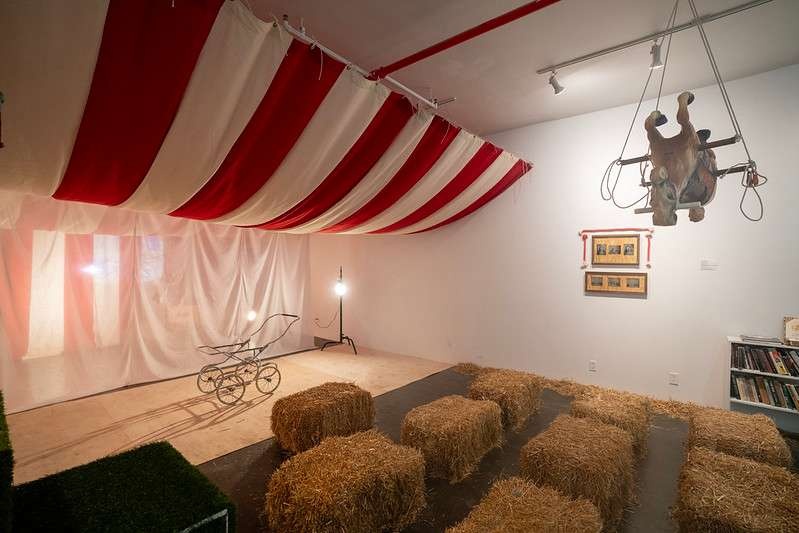Between the current perception and the interposed memory there is a “mutual tension” that both enables them to intervene into the operations of the other but that also stabilizes and holds the past and the present apart. Perception can never be free of memory and is thus never completely embedded in the present, but always retains a reservoir of connections with the past as well as a close anticipation of the imminent future. The present is extended through memory into the past and through anticipation into the near future.[1]
Elizabeth Orr’s Circular Track, 2013, consists of a track, formed by two translucent, concentric circles placed on the floor. The track is a path for a camera, mounted on a dolly, circulating in space. For Orr’s residency at Recess, the circle is a proposition; offered as an alternative to linearity, the track is an active site to interrogate positions, movement and time. Concentric circles can represent the connection between perception and memory, as described by Henri Bergson, who used them to diagram this relationship. Elizabeth Grosz writes on Bergson “It is not clear, even with reflection, whether we can accurately separate the elements derived from the present from those from the past: they form a complete and seamless whole.”[2]
Circular Track invites return and re-tracing. Yet each turn around the track is not a repetition. Even the most faithful repetition of a gesture, by the most exacting performer represents a shift. It is by necessity asynchronous with the previous action, falling at a different moment in time, drawing on, but never perfectly mirroring the gesture that precedes it. As the camera circulates over the track, each turn is different from the one before, each return is a shift.
The act of encircling connotes a power relationship. Circles suggest inclusion and exclusion. While the circle as a form does not intrinsically disrupt or dominate hegemonic structures, it carries potential as a configuration for gathering. It can be a form that enables assembly, for example the history of feminist organizing through circles for consciousness-raising. This formal aspect of the track – its basic path – enacts an operation by drawing attention to framing and movement, questioning underlying notions of neutrality and objectivity.
In focusing on camera movement, Circular Track calls for thinking about how devices capture, how they travel – their range of motion.[3] How does a camera phone move through a crowded demonstration? In what direction is a surveillance camera pointed, adjusted, and how do bodies negotiate the surveyed space? When a camera is mounted on a drone, how is it navigated and choreographed overhead? As images, and by extension the devices that capture them circulate with increasing speed – the track and affixed camera could be considered agents, with the potential to shift outcomes of events.
During Orr’s residency, the problem of the image arose: Is it possible to record a void? If the circular track encircles a void can it be detected? If there is no discernible subject, or object represented in the frame, does the apparatus, the camera itself, become the subject? In the absence of a subject – is the movement of the camera visible? If images hold power, disappearance becomes a tactic. Withdrawal and the act of vanishing become vested with power. The videos and performances that extend from Circular Track are not recordings of a void. These works have subjects – bodies or objects that are implicated- and yet – this question remains central to the project. As tracking is fore grounded as an operation – movement – and its relationship to time and affect becomes primary.
The tracking shot is an in-camera effect, occurring during the process of recording rather then in postproduction. Orr emphasizes its construction within the camera, a process that could be compared to other techniques such as the generation of a GIF, that is both generated and viewed through digital means. Orr has researched and traced the tracking shot (the shot captured as the camera is maneuvered on a dolly) by amassing clips from myriad sources and systematically classifying them. This body of research includes related shots where the camera follows a subject in a frame, such as the long take, the alongside and on ride. Through this undertaking, Orr outlines a typology of the tracking shot, based on the relationship between movement and tracking. This classification system includes four categories: tracking an action, tracking despite movement, tracking to shift perception, and action following the track.
Tracking an action – is “moving WITH action” or “moving FOR something”. Related shots include on ride camera movements, such as the use of a camera to document a route or a moving vehicle. Orr identifies this type of shot with reflecting or creating emotion, giving the example of a scene from The Shining, 1980, where the camera takes on the haunting of the hotel, trailing behind a small boy riding his tricycle. The camera is situated low to the ground at the boy’s level and keeps pace with his action as he travels through the hotel.
Tracking DESPITE movement is “Action moving AGAINST action” when an aspect of agency could be attributed to the camera outside of the content. Examples of this relationship include the camera as a character, or a camera that resists movement as action unfolds. Orr offers the example of the scene in Jean-Luc Godard’s Weekend, 1967, where the camera pans independently across a seemingly endless traffic jam.
In shots categorized as tracking to shift perception, the tracking generates the movement of the frame. A brilliant example of this is a scene that Orr identifies in Martha, 1974, by Rainer Werner Fassbinder. In the shot a man and a woman walk towards one another, the shot comes in and encircles them, and they are intertwined for a moment before it releases as they set off in separate directions once more. Orr describes the fourth category – Action following the track as “invisibility and possibility through a live performance.” This action is initiated from a desire to be on camera, as opposed to the camera tracking movement or the camera tracking through the movement.
Movement in itself is projective, implying possibility.[4] This correlates with the expectation that time and progress are bound to each other, braiding together towards the future. Tom Gunning, a professor of Cinema and Media Studies, has proposed that if all genres of cinema are considered as a form of animation, then cinematic motion (rather photographic imagery) becomes primary.[5] Gunning ascribes a particular effect to the perception of motion, drawing on theorist Christian Metz, who has pointed out that in terms of psychology and perception – movement is always perceived as real, in contrast to other kinds of visual qualities, for example volume, which is not always as readily accepted as reality.[6] This is exemplified through the potential of shots that engage with tracking and movement to influence perception.
In Measuring the Circular Track, 2013, a video featuring Emma Hedditch, created with the track, Hedditch maps and measures the radius of the track, remaining still while the camera circulates around her. In exploring cinema and animation’s relationships to reality, Lev Manovich writes:
…cinema works hard to erase any traces of its own production process, including any indication that the images which we see could have been constructed rather than recorded. It denies that the reality it shows often does not exist outside of the film image, the image which was arrived at by photographing an already impossible space, itself put together with the use of models, mirrors, and matte paintings, and which was then combined with other images through optical printing. It pretends to be a simple recording of an already existing reality — both to a viewer and to itself.[7]
Orr takes an inverse approach to the means of production and emphasizes these traces of production. In Hedditch’s act of measurement and attempt at training the track with tape, the short video draws attention to its construction, and motion conveys a sense of reality. The video performs two operations. It takes up a very specific mechanism for construction, and it is formalist yet anti-illusionist, producing a tension between construction and recording. Circular Track operates by drawing attention to the camera’s movement, foregrounding this aspect of production and the construction of the images that this mechanism produces.
Filmmakers in the teens and twenties were excited to discover the possibility of affecting viewers physiologically and emotionally through movement – experimenting with scenes of chases, horses and trains in motion. If we consider camera movement as choreography, then it becomes necessary to consider both the body that controls the camera as well as the spectator’s body. This raises the question of how movement is determined and how viewers situate their own bodies in relation to what is captured through the lens. Considering kinesthesia acknowledges that film spectators are embodied beings (rather then just eyes).[8] Orr flips what is typically thought of as an ocular, disembodied experience, and draws attention to its structure, to the bodies and gestures that are implicated in its production. The project underscores the choreography of the camera, kinesthesia and embodied viewing.
The camera can be a window into the perception or point of view of a protagonist. In the opening scene of Brian De Palma’s Bonfire of the Vanities, 1990, the shot is precarious and unstable, as the camera takes on the faltering state of its subject, reflecting drunkenness through the camera, and stirring empathy from the viewer. In a sense, the spectator is dropped in to their body, and the scene is framed through the experience of the character. A similar act of embodiment is especially pronounced through Orr’s performance work through a relationship between the spectators, the operator of the camera on the track, the subject being filmed, and projection in a real-time of the recording.
Douglas Gordon’s video Domestic (as long as it lasts), 2002, records a camera as it is kicked around, until its eventual electronic death. Although here it is an object’s perspective, rather then a human character, there is still a feeling of horror evoked from the pain of the camera. Gordon’s camera is vulnerable, and the act of viewing it incites an emotional response. Gordon’s film draws attention to the violence that can accompany spectatorship by positioning the apparatus as an “observed observer”.[9]
Orr’s research is grounded in an engagement with a specific cinematic technique that centers on an observed observer. This study attends to the interaction between subjects, positions and movement, generating a body of research is at once specialized, tied to the realm of cinema, yet also extends outward, begging a broader consideration for mechanisms for recording images. Here, the camera and the track operate together forming a device of capture.
The track operates in the studio as a laboratory that tests the resonance of tracking and movement. The construction of the circle engages time – as the present intersects with memories of the past and expectations of the future. In attending to movement, it allows for an exploration of kinesthesia – of physiological responses experienced, sensations felt in the stomach – in the body itself. Circular Track is an artwork that attempts to reshift focus from the problem of the image, the object of representation, towards the apparatus.[10] Orr does not sidestep the image; rather, the track is an experiment in distillation.
In focusing on the movement of the camera itself, Circular Track tests the seams of the moving image. It returns, retraces, and by refocusing attention on the choreography of the camera it implicates the bodies of subjects, of producers and of spectators. In revisiting a cinematic tool, Circular Track explores tracking, movement, positions and agency, raising complicated questions about the devices of capture that circulate in the world, on the track and beyond.
Footnotes
-
E. A Grosz, The Nick of Time: Politics, Evolution, and the Untimely (Durham: Duke University Press, 2004), 173.
-
Ibid., 173.
-
Hito Steyerl has written “photographic or moving images are dangerous devices of capture: of time, affect, productive forces, and subjectivity.” Hito Steyerl and Franco Berardi, “The Spam of the Earth: Withdrawal from Representation,” The Wretched of the Screen (Berlin: Sternberg Press, 2012), 168.
-
Tom Gunning, “Moving Away from the Index: Cinema and the Impression of Reality,” Differences. 18, no. 1 (2007): 42.
-
Ibid., 173.
-
Gunning, “Moving Away from the Index,” 41.
-
Lev Manovich, “What is Digital Cinema?” https://www.manovich.net/TEXT/digital-cinema.html
-
Gunning, “Moving Away from the Index,” 39.
-
David Levine, presentation at “The Flood of Rights” Symposium, Arles, France, September 19-21, 2013.
-
Amanda Beech discussed the shift between the problem of the image and the apparatus in her presentation at “The Flood of Rights” Symposium.
About the artist
Clara Halpern
Projects
Explore/Archive
See allDecember 2025
The INSTITUTE FOR TRANSHUMANIST CEPHALOPOD EVOLUTION and Learning from Octopuses
Barbara London
Barbara London reflect's of Miriam SImun's INSTITUTE FOR TRANSHUMANIST CEPHALOPOD EVOLUTION
October 2025
streamlined reflections, courtesy of noise canceling headphones
Gabrielle Rucker
Gabrielle Rucker reflects on the radical intimacy and auditory life at the heart of Deli Radio
July 2025
Tell My Jockey: CUNTRY’s Discourse From the Horse’s Mouth
Ericka Pérez
Assembly fellow Ericka Pérez reflects on clowning, resistance, and CUNTRY’s radical refusal to perform.







